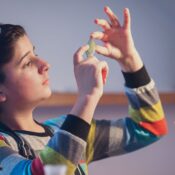Building Futures Together: The Impact of Community Support on Learning Spaces
Education is the cornerstone of a thriving society. It’s where young minds are nurtured and their curiosity is sparked. It’s where future generations are equipped with the critical skills and social tools they need to succeed. However, a student’s success isn’t solely determined by textbooks; their learning environment plays a crucial role.
The education of our youth extends far beyond classrooms and textbooks. It is a comprehensive journey that shapes students from their first day of school to the moment they cross the stage at graduation. And a student’s success isn’t solely determined by curriculum; their learning environment plays a crucial role. When students feel supported, inspired, and empowered, they truly flourish.
Community support for learning spaces is absolutely vital. It enhances educational experiences, creating more inclusive, innovative, and effective classrooms. Whether it’s through community-funded school projects, public-private partnerships, or grassroots initiatives, local involvement strengthens the very foundation of learning.
The Power of Community Involvement in Education
Communities that invest in education create more than just better school infrastructure, they build brighter futures. Community involvement in education brings resources, ideas, and financial backing that schools may not otherwise receive. From renovating classrooms to funding libraries and STEM labs, local efforts ensure that students have access to high-quality learning environments.
By fostering partnerships between parents, businesses, nonprofits, and educators, schools can address gaps in funding and resources, ultimately improving student outcomes. Through community engagement, education becomes a shared responsibility, fostering pride and investment in the success of future generations.
When communities become actively involved in education, the results can be truly transformative.
Creating Inclusive Learning Spaces: Fostering Diversity in Education
An inclusive learning space is one that embraces diversity, ensuring every student has the opportunity to succeed, regardless of background or abilities. Creating inclusive learning spaces is about more than just physical accommodations; it’s about fostering a culture of respect and belonging where all students feel valued.
Inclusive learning spaces are designed with accessibility in mind. Whether it’s through specialized equipment, adaptable classroom layouts, or technology that supports diverse learning styles, these spaces cater to students with varying needs. Community-driven initiatives can help provide these resources, ensuring that every child has an equal chance to succeed in school.
In addition to physical accommodations, inclusivity in learning environments extends to curriculum and teaching practices. Community involvement in education can help develop and fund initiatives that reflect the diverse cultural backgrounds of students, making learning more relatable and engaging. When communities prioritize inclusivity, they contribute to an educational system that nurtures the growth of all students.
The Role of Communities in Education: A Shared Vision
Schools do not stand alone; they are an active reflection of the communities they serve. When families, local businesses, and civic organizations invest in education, students gain access to resources that enrich their learning experiences. Volunteering, mentorship programs, and financial contributions all contribute to a stronger educational experience.
Community support also fosters a culture of learning. Book drives put stories in kids’ hands, after-school programs give students a safe place to grow, and scholarships open doors to brighter futures. When a community rallies around its schools and youth, it sends a powerful message: every child deserves the chance to learn, thrive, and succeed.
These efforts not only enhance the learning experience for students but also create a sense of ownership and pride within the community. When everyone plays a role in supporting education, the entire community benefits.
The Power of Community-Backed Educational Initiatives
Communities that invest in education create lasting change, providing students with opportunities they might not have otherwise. From grassroots movements to large-scale initiatives, community involvement fosters learning environments that go beyond textbooks and traditional classrooms.
Take, for example, Partners for Rural Impact (PRI) in Eastern Kentucky. Inspired by the Harlem Children’s Zone, PRI takes a “cradle-to-career” approach, supporting students in disadvantaged rural communities with educational, medical, and social resources. By connecting schools with local services, businesses, and nonprofits, PRI has demonstrably improved educational outcomes, even amidst challenges like the recent pandemic.
Another inspiring initiative is the Arethusa Farm Foundation in Connecticut. Originally a dairy farm, Arethusa has been transformed into a hands-on learning hub, partnering with institutions like UConn and Cornell University. Through internships and agricultural programs, students gain practical, real-world experience in environmental science, farming, and sustainability. This innovative approach educates and strengthens the connection between schools and local industries.
These initiatives, and many others, prove that learning spaces aren’t always confined to four walls; sometimes, they’re in fields, barns, laboratories, and within the network of support that a community provides.
Public-Private Partnerships in Education: Expanding Opportunities
While community-driven initiatives play a crucial role in reshaping education at the local level, public-private partnerships take this effort a step further, offering students even greater resources and opportunities.
Public-private partnerships in education have proven effective in expanding educational resources beyond what traditional school budgets allow. Businesses and nonprofits often collaborate with schools to build new facilities, provide technology, and offer enrichment programs.
Salesforce’s Education Initiatives have invested millions into schools in San Francisco, Oakland, and other major cities, providing funding for STEM education, teacher training, and technology resources. These partnerships have helped students gain real-world experience in coding, data science, and AI.
The LeBron James Family Foundation’s I PROMISE School in Akron, Ohio, is an outstanding example of a public-private partnership. Supported by LeBron James and local organizations, the school provides a comprehensive support system for grades 1 through 8, including free meals, bikes, and mentorship programs to ensure student success.
These partnerships underscore the power of collaboration, demonstrating how businesses, nonprofits, and schools working together can create limitless opportunities for enriching educational experiences and preparing students for future careers.
Community-Funded School Projects: Revitalizing Infrastructure
The spirit of community support extends beyond large-scale partnerships to encompass initiatives focused on revitalizing school infrastructure. In many underserved districts, outdated classrooms and deteriorating buildings hinder learning. Community-led initiatives have stepped up to renovate and modernize these spaces.
A notable example is Capitol Elementary School in San Francisco, where parents, teachers, and residents came together to redesign and upgrade the school’s physical environment. This collaborative effort not only transformed the school into a more conducive learning space but also sparked a revitalization of the surrounding neighborhood, showcasing the power of community involvement in improving educational infrastructure.
Another example is The Baltimore Community Foundation’s School Grant Program, which provides funding for school renovations, technology upgrades, and STEM labs, ensuring that students have high-quality, modernized learning environments.
These projects demonstrate how community-funded school projects directly enhance student engagement, motivation, and academic success.
How TeacherGiving Supports Community-Backed Educational Initiatives
Teachers pour their hearts into their classrooms, but too often, they’re left to cover the costs of supplies, technology, and learning tools on their own. That’s where TeacherGiving comes in. It is a platform that connects educators with community members who want to help.
With TeacherGiving, teachers can quickly set up personalized fundraising pages, share their stories, and receive direct support from people who care, without the frustration of lengthy grant applications or red tape. Built on transparency and ease of use, TeacherGiving provides a place where educators can quickly set up personalized fundraising pages, share their stories, and receive direct community support, without the hassle of lengthy grant applications.
Every dollar goes straight to verified educators, offering full transparency on how funds are used. Unlike traditional funding models that come with restrictions, TeacherGiving gives teachers the freedom to shop where they want, including local businesses, so they can get exactly what their students need.
By removing barriers to funding, TeacherGiving makes it easier for communities to step up and support their schools in a meaningful way. Whether you’re an educator looking for resources or a supporter hoping to make a real difference, TeacherGiving provides a simple and impactful way to invest in the future, one classroom at a time.
Whether you’re an educator in need of resources or a supporter looking to make a direct impact, TeacherGiving makes it easy to be a champion for classrooms.
Conclusion
The impact of community support for learning spaces cannot be overstated. Whether through community-funded school projects, public-private partnerships in education, or initiatives that create inclusive environments, local involvement shapes the future of education. When communities come together, they build more than just classrooms. They build opportunity, equity, and inspiration for generations to come. Platforms like TeacherGiving provide a bridge between educators and the community, ensuring that every student has access to a thriving learning environment. By working together, we can transform education and empower students to reach their fullest potential.
Share:
Inspired by the TeacherGiving blog?
Discover resources, strategies, and stories that empower educators and transform classrooms. From fundraising tips to free downloadable tools, our blog is your go-to guide for innovative teaching and impactful learning. Subscribe today and never miss an update!
Recent Posts
12 States Lead Way in Providing Above Average Education
Navigating Digital Reading: Empowering Students in Internet-Based Learning
Unlock the Importance of Non-Classroom Learning Environments
End of the School Year Celebrations: Why They Matter

Be a Champion for Classrooms
Whether you’re an educator needing support or a supporter wanting to make a difference, TeacherGiving is here for you. Create an account or donate to help educators and enrich students’ learning experiences. Join us today and be a champion for classrooms!






